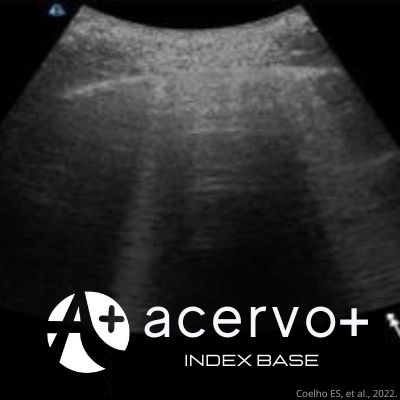Confiabilidade interobservadores do diagnóstico de congestão pulmonar de pacientes em hemodiálise por exame ultrassonográfico Point-Of-Care (POCUS)
##plugins.themes.bootstrap3.article.main##
Resumo
Objetivo: Comparar a confiabilidade da avaliação de congestão pulmonar pela ausculta e pelo POCUS em pacientes hemodialíticos realizada por diferentes examinadores: médico habilitado e acadêmico de Medicina. Métodos: Estudo com pacientes em hemodiálise na clínica Pró-Renal. Foram coletadas as comorbidades e sinais clínicos de congestão em conjunto com a ultrassonografia, escaneando oito áreas pulmonares para identificar presença de linhas B. Resultados: De 30 pacientes, 36,6% apresentavam edema periférico e 13,3% turgência jugular. A prevalência de congestão pulmonar avaliada pelo médico na ausculta e no exame ultrassonográfico foi de13,3% e de 50,0%, respectivamente. Na avaliação dos acadêmicos, ambos obtiveram prevalência de 20% pela ausculta, já pela ultrassonografia foi de 60,0% e de 50,0%. Na avaliação pela ausculta entre o médico e os acadêmicos, observou-se uma concordância moderada (κ=0,48) e baixa (κ=0,19), respectivamente. Na congestão pulmonar avaliada pelo POCUS, entre o médico e o acadêmico 1 observou-se uma concordância substancial (κ=0,67), e moderada (κ=0,47) para o acadêmico 2. Conclusão: O POCUS para o diagnóstico de congestão pulmonar foi superior à ausculta, sendo confiabilidade moderada e substancial entre o médico e os acadêmicos no diagnóstico pelo POCUS, no entanto, na ausculta encontrou-se uma concordância moderada e baixa.
##plugins.themes.bootstrap3.article.details##
Copyright © | Todos os direitos reservados.
A revista detém os direitos autorais exclusivos de publicação deste artigo nos termos da lei 9610/98.
Reprodução parcial
É livre o uso de partes do texto, figuras e questionário do artigo, sendo obrigatória a citação dos autores e revista.
Reprodução total
É expressamente proibida, devendo ser autorizada pela revista.
Referências
2. BÜRGI U, HUBER LC. Die Lungenauskultation – Erkenntnisse und Irrtümer: Lung auscultation – an overview. Dtsch Med Wochenschr., 2015; 140(14): 1078–1082.
3. DESANTI RL, et al. The Inter-Rater Reliability of Pediatric Point-of-Care Lung Ultrasound Interpretation in Children With Acute Respiratory Failure. J Ultrasound Med., 2022; 41(5): 1159- 1167.
4. DI NICOLÒ P, et al. Lung Ultrasound in Hemodialysis: A Card to be Played? Blood Purif., 2017; 44(1): 1-7.
5. ENIA G, et al. Lung Comets Cohort Working Group. Asymptomatic pulmonary congestion and physical functioning in hemodialysis patients. Clin J Am Soc Nephrol., 2013; 8(8): 1343-8.
6. HAFKE-DYS H, et al. The accuracy of lung auscultation in the practice of physicians and medical students. PLos ONE, 2019; 14(8): 1-16.
7. KALANTAR-ZADEH K, et al. Fluid retention is associated with cardiovascular mortality in patients undergoing long-term hemodialysis. Circulation, 2009; 119(5): 671- 9.
8. KUMAR V, et al. Robbins Patologia Básica. 2018; 10th ed. Rio de Janeiro: Elsevier Editora Ltda. 909p.
9. LICHTENSTEIN DA, et al. A-Lines and B-Lines: Lung Ultrasound as a Bedside Tool for Predicting Pulmonary Artery Occlusion Pressure in the Critically Ill. Chest, 2009; 136(4): 1014-1020.
10. LOUTRADIS C, et al. Lung Ultrasound-Guided Dry Weight Assessment and Echocardiographic Measures in Hypertensive Hemodialysis Patients: A Randomized Controlled Study. Am J Kidney Dis., 2020; 75(1): 11-20.
11. LOUTRADIS C, et al. Ambulatory blood pressure changes with lung ultrasound-guided dry-weight reduction in hypertensive hemodialysis patients: 12-month results of a randomized controlled trial. J Hypertens., 2021; 39(7): 1444-1452.
12. PANUCCIO V, et al. Lung ultrasound to detect and monitor pulmonary congestion in patients with acute kidney injury in nephrology wards: a pilot study. J. Nephrol., 2020; 33(2): 335-341.
13. PAUDEL K, et al. Comparing lung ultrasound with bioimpedance spectroscopy for evaluating hydration in peritoneal dialysis patients. Nephrology (Carlton), 2015; 20(1): 1-5.
14. RISLER Z, et al. Medical students are accurate in interpreting the presence of pathologic interstitial edema on focused lung ultrasound compared to expert reviewers. AEM Educ Train, 2021; 5(2): e10584.
15. ROMÃO JUNIOR JE. Diretriz Clínica da Doença Renal Crônica: Definição, Epidemiologia e Classificação. Braz. J. Nephrol., 2004; 26(3supl.1): 1-3.
16. ROSS DW, et al. Lung ultrasonography in end-stage renal disease: moving from evidence to practice— a narrative review. Clin Kidney J., 2018; 11(2): 172–178.
17. SAAD MM, et al. Relevance of B-Lines on Lung Ultrasound in Volume Overload and Pulmonary Congestion: Clinical Correlations and Outcomes in Patients on Hemodialysis. Cardiorenal Med., 2018; 8(2): 83-91.
18. SO S, et al. Ultrasound imaging in medical student education: Impact on learning anatomy and physical diagnosis. Anat Sci Educ., 2017; 10(2): 176-189.
19. TORINO C, et al. The Agreement between Auscultation and Lung Ultrasound in Hemodialysis Patients:The LUST Study. Clin J Am Soc Nephrol., 2016; 11(11): 2005-2011.
20. TREZZI M, et al. Lung ultrasonography for the assessment of rapid extravascular water variation: evidence from hemodialysis patients. Intern Emerg Med., 2013; 8(5): 409-15.
21. VIEIRA JR, et al. Avaliação das linhas B pulmonares utilizando ultrassonografia à beira leito por diferentes médicas intensivistas: um estudo de confiabilidade. Rev. bras. ter. Intensiva, 2019; 31(3): 354-360.
22. VITTURI N, et al. Lung ultrasound during hemodialysis: the role in the assessment of volume status. Int Urol Nephrol., 2014; 46(1): 169-74.
23. WIPF JE, et al. Diagnosing pneumonia by physical examination: relevant or relic? Arch Intern Med., 1999; 159(10): 1082-7.
24. WONGWAISAYAWAN S, et al. Emergency Thoracic US: The Essentials. Radiographics, 2016; 36(3): 640-59.
25. WOOTEN WM, et al. Bedside Ultrasound Versus Chest Radiography for Detection of Pulmonary Edema: A Prospective Cohort Study. J Ultrasound Med., 2019; 38(4): 967-973.
26. ZOCCALI C. Lung Water by Ultrasound Guided Treatment in Hemodialysis Patients (The Lust Study). Clinical Trials; 2014.
27. ZOCCALI C, et al. Pulmonary congestion predicts cardiac events and mortality in ESRD. J Am Soc Nephrol., 2013; 24(4): 639-46.

